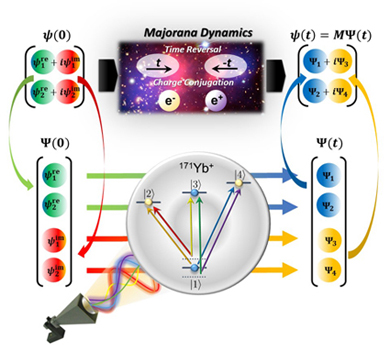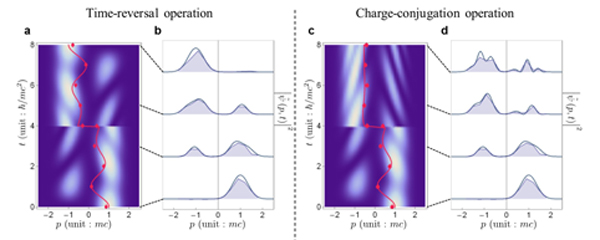The First Realization of Embedding quantum simulation in a trapped system Published in Nature Communications from Prof. Kim’s ion trap group
Prof. Kim’s ion trap group at Center of Quantum Information (CQI) of Institute for Interdisciplinary Information Sciences (IIIS) has realized the first embedding quantum simulator in the trapped ion system. The paper, which is entitled as “Time Reversal and Charge Conjugation in an Embedding Quantum Simulator”, was published on August 4th, in Nature Communications. The first author is IIIS PHD candidate Xiang Zhang, with corresponding authors Associate Prof. Kihwan Kim and Assistant Researcher Jing-ning Zhang.

Figure 1: Schematic of the embedding quantum simulator implemented in a trapped ion system. The upper and lower parts represent the original and enlarged spaces, respectively. Unphysical processes, which are forbidden by the laws of quantum mechanics, are mapped to unitary operations in the enlarged space.
Quantum simulators are devices designed to simulate the properties of ideal quantum models and would allow to study quantum systems which could not be efficiently simulated by any classical means. However, they are not yet able to perform some basic arithmetic calculations as the complex conjugate. In this sense, operations involving the complex conjugate require an anti-unitary process, which is impossible to be implemented in a quantum system. Such complex conjugate is deeply connected to the important concepts in quantum field theory that unify quantum mechanics and special relativity, i.e., discrete symmetries like charge conjugation and time reversal.
For the first time, it is performed the complex conjugation and these symmetry operations in our trapped-ion quantum system through the use of enlarged spaces and the novel concept of embedding quantum simulator. The embedding quantum simulator was proposed by Prof. Solano’s group at University of the Basque Country in Spain. Our realization can be applied to numerous quantum calculations and simulations that require access to the implementation of unphysical operations. The experiments explore a completely new direction in the field of quantum simulation, and introduce “unphysical” operations into the toolbox of quantum simulation. The embedding quantum simulator can also be used to measure physically meaningful non-observables, such as the entanglement monotones and multi-time correlation functions.

Figure 2 Time reversal and charge conjugation on the Majorana dynamics in momentum space. The evolution is governed by the Majorana equation and the symmetry operations are performed at the midpoint t = 4. a,b. Right after the time-reversal operation, the momentum as well as the velocity changes sign. c,d. By definition, the particle and corresponding antiparticle have opposite momentum but the same velocity. As a result, right after the charge-conjugation operation, the average momentum is reversed but not the velocity.
The experiments were carried out by IIIS PhD candidates Xiang Zhang, Yang-chao Shen and Jun-hua Zhang. Besides the corresponding authors, the authors also include Assistant Prof. Man-Hong Yung from Tsinghua University, together with Dr. Jorge Casanova, Dr. Lucas Lamata, and Prof. Enrique Solano from University of the Basque Country in Spain. The research was funded by National Basic Research Program of China, the National Natural Science Foundation of China, and the 1000-Talent Youth Program of China.
The full paper is available at: http://www.nature.com/ncomms/2015/150804/ncomms8917/full/ncomms8917.html
(From IIIS,Tsinghua)

